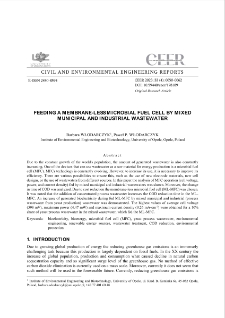Digital Library of Zielona Góra contains 63 456 digital objects
Object
Title: Feeding a Membrane-less Microbial Fuel Cell by Mixed Municipal and Industrial Wastewater
Contributor:
Group publication title:
Abstract:
Due to the constant growth of the world`s population, the amount of generated wastewater is also constantly increasing. One of the devices that can use wastewater as a raw material for energy production is a microbial fuel cell (MFC). MFCs technology is constantly evolving. However, to increase its use, it is necessary to improve its efficiency. There are various possibilities to ensure this, such as the use of new electrode materials, new cell designs, or the use of wastewaters from different sources. ; In this paper the analysis of MFC operation (cell voltage, power, and current density) fed by mixed municipal and industrial wastewaters was shown. Moreover, the change in time of COD was analyzed. Due to cost reduction the membrane-less microbial fuel cell (ML-MFC) was chosen. It was noted that the addition of concentrated process wastewater increases the COD reduction time in the ML-MFC. ; An increase of generated bioelectricity during fed ML-MFC by mixed municipal and industrial (process wastewater from yeast production) wastewater was demonstrated. The highest values of average cell voltage (598 mV), maximum power (4.47 mW) and maximum current density (0.26 mA?cm-2) were obtained for a 10% share of yeast process wastewater in the mixed wastewater, which fed the ML-MFC.
Description:
tytuł dodatkowy: Prace z Inżynierii Lądowej i Środowiska
Publisher:
Zielona Góra: Oficyna Wydawnicza Uniwersytetu Zielonogórskiego
Format:
Resource Identifier:
DOI:
Pages:
Source:
Civil and Environmental Engineering Reports (CEER), no 33, vol. 4
Language:
License CC BY-NC-ND 3.0:
Rights:
Biblioteka Uniwersytetu Zielonogórskiego
Object collections:
- Digital Library of Zielona Góra > Repository > Faculties > Construction department, Architecture and Environmental Engineering
- Digital Library of Zielona Góra > Repository > Types of work > Articles
- Digital Library of Zielona Góra > Repository > Scientific journals and UZ publishing series > Civil and Environmental Engineering Reports (CEER) > Civil and Environmental Engineering Reports (CEER) (2023)
Last modified:
Feb 5, 2024
In our library since:
Feb 5, 2024
Number of object content hits:
171
All available object's versions:
https://www.zbc.uz.zgora.pl/publication/87010
Show description in RDF format:
Show description in OAI-PMH format:
| Edition name | Date |
|---|---|
| Feeding a Membrane-less Microbial Fuel Cell by Mixed Municipal and Industrial Wastewater | Feb 5, 2024 |
Objects Similar
Włodarczyk, Paweł Włodarczyk, Barbara Kuczyński, Tadeusz - red.
Włodarczyk, Barbara Włodarczyk, Paweł Kuczyński, Tadeusz - red.
Włodarczyk, Paweł Włodarczyk, Barbara Kuczyński, Tadeusz - red.
Bujarkiewicz, Adam Sztubecka, Małgorzata Sztubecki, Jacek Kuczyński, Tadeusz - red.
Łączak, Andrzej Bazan-Krzywoszańska, Anna Mrówczyńska, Maria Skiba, Marta Kuczyński, Tadeusz - red.
Żołądek, Maciej Sornek, Krzysztof Papis, Karolina Figaj, Rafał Filipowicz, Mariusz Kuczyński, Tadeusz - red.
Ziembicki, Piotr Bernasiński, Jan Kuczma, Mieczysław - red.
Jakubaszek, Anita Stadnik, Artur Greinert, Andrzej - red.

